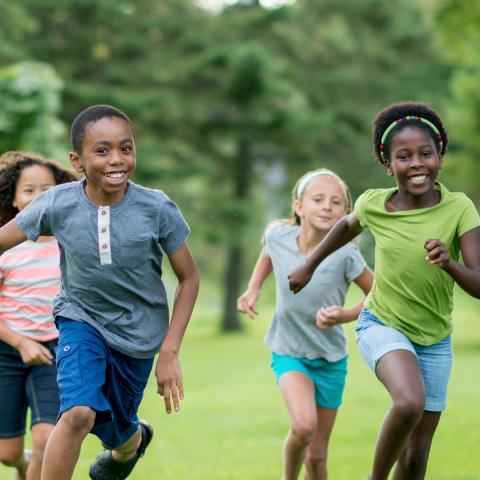
Q&A featuring Paul André Cyr, EAO, Teacher at St. Marguerite d'Youville
1. Why do you feel inquiry is such a powerful approach to engage students in learning?
Inquiry is empowering. It allows students to gain greater control of their learning, and to become more critical of their progress. Students are asked to actively contribute to developing the criteria for their success, and have the chance to reflect on their personal growth.
Throughout their schooling, students are engaged and further motivated to learn. By fostering Independence, inquiry is one of the most effective paths towards student motivation. It allows students to gain independence as they progress, build confidence and are able to actively contribute to their own learning.
2. Why is it important for H&PE teachers to adopt an inquiry approach in H&PE?
Students have varying levels of experience and ability when it comes to being physically active. Not every student has the opportunity to participate in extracurricular activities. While succeeding in H&PE was historically synonymous with athletic performance, this is no longer the case. Physical education is now oriented towards student centred learning, focusing on an individual’s skill development, and providing students with opportunities to practice and reflect on their learning. This applies to both movement and interpersonal skills. Inquiry-based learning not only creates opportunities for students to succeed in developing motor skills through exploration and reflection, but also provides the opportunity for students to collaborate with others, and apply their interpersonal, and critical and creative thinking skills.
Demonstrating cooperation and critical thinking skills in game strategy is also as important as game performance. An inquiry-based approach supports educators in teaching and evaluating the growth of personal and interpersonal skills as well as the understanding of cooperation, critical thinking and concepts. Furthermore, it increases a student’s opportunity to succeed and lead a healthy, active life.
3. Please provide a specific example of an inquiry-based approach to learning you have used to support student learning in H&PE. How do you use inquiry to help students develop their movement skills as they participate in physical activity?
Second graders enjoy being entertained. They are also at the age where those who partake in extracurricular physical activities gain quite a bit of an advantage in the development of their basic movement skills. To some, basic movements (as in this case, the underhand throw) have long been acquired. For others, everything can seem to “go wrong”: the student may have an incorrect stance, hold objects incorrectly, or may have difficulty with timing and aiming.
Teaching students self-direction is an important concept in an inquiry-based approach, and modelling critical thinking skills in front of students can be an incredibly efficient way to have them self-evaluate their movements. Additionally, the best way to demonstrate does not always have to be by demonstrating proper underhand throwing techniques and then have them analyze it. Instead, try the opposite - emulate your students’ cumulative mistakes and become the worst underhand thrower you can imagine, clumsily looking for their help to improve your technique. Ask for their advice on which foot to put forward, humorously demonstrating how contorted someone can become when not placing the opposite foot forward to the throwing hand. Hold the thrown object in funny ways, and have students share their tips on how to properly grasp the object. Furthermore, provide examples of letting go of your object too early or too late in your throwing phase, with entertaining results. Lastly, after having listened to their suggestions for an improved technique, demonstrate the proper movement skill technique and solicit their reasoning as to why they allow for greater success.
While some students may undoubtedly find such an approach amusing, it supports students in forming opinions and learning how to reflect on their own performance. When given the chance to then apply their knowledge, students are able to develop critical thinking skills and discover ways to improve their techniques and movement skills.
4. How does inquiry enhance student learning when it comes to the Living Skills?
As stated above, Physical education is now oriented towards student centred learning, focusing on an individual’s skill development and their acquisition of interpersonal skills that are beneficial in every facet of their lives.
An inquiry-based approach encourages students to develop self-awareness by having them question and evaluate their performance, and communicate their observations within the group. Instead of placing a stigma on a student’s failures or reticence, mistakes are encouraged — allowing for an opportunity to grow. Progress is seen as positive. Goals and challenges are encouraged. And sharing of a success or a failure is not subject to mockery. It is instead appreciated as a collaborative gesture.
For many students, physical education can be daunting, especially when some peers can seem to have more natural physical abilities. However, an inquiry-based approach is inclusive and favours the success of all students. Furthermore, it also encourages students to take risks and discuss the advantages with teammates - building on personal decision-making skills and team work (regardless of the outcome).
5. If an educator is new to using inquiry in H&PE, what advice would you give them?
Try, and try often. Much like our objective for students, the goal is not for educators to understand and apply every component of this approach at once. It is not about performance, but rather progress.
An inquiry-based approach can be integrated into any lesson plan, and can be done individually as well as with a larger group. If you’re uncertain of where to start, remember that you can start with small efforts at any stage of the process. The goal of an inquiry-based approach is to have students reflect on their own learning and how they can succeed and gain new knowledge and skills to lead a healthy, active life. There is never a wrong time to integrate inquiry into your lessons!
